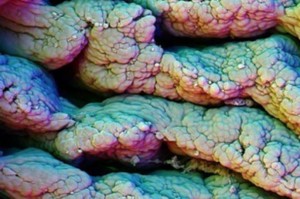 Learning to become a medical assistant includes a lot of information about basic anatomy, physiology and a host of other important facts. What is covered in the medical assistant training course is certainly in-depth, but not perhaps as in-depth as the slide show linked here which shows what the amazing human body and its respective parts look like under strong magnification. Most medical assistants will contribute efforts toward treating ailments affecting a wide variety of body parts, but few will ever see these “close-ups” on a regular basis.
Whether we’re talking about neurons in the brain, tastebuds on the tongue, fingernails, small intestines, teeth, red blood cells, sweat, burnt skin, blood platelets, breast cancer cells or other items, most of what we see and experience regarding these items is dealt with in abstract terms. Getting to see these images up close, under great magnification really exposes the wonder and mystery of the human body and the processes which govern health and wellness. Have a look under the microscope and be prepared to be captivated anew at the marvels of science that inform the venerable and important field you’re about to enter.
Learning to become a medical assistant includes a lot of information about basic anatomy, physiology and a host of other important facts. What is covered in the medical assistant training course is certainly in-depth, but not perhaps as in-depth as the slide show linked here which shows what the amazing human body and its respective parts look like under strong magnification. Most medical assistants will contribute efforts toward treating ailments affecting a wide variety of body parts, but few will ever see these “close-ups” on a regular basis.
Whether we’re talking about neurons in the brain, tastebuds on the tongue, fingernails, small intestines, teeth, red blood cells, sweat, burnt skin, blood platelets, breast cancer cells or other items, most of what we see and experience regarding these items is dealt with in abstract terms. Getting to see these images up close, under great magnification really exposes the wonder and mystery of the human body and the processes which govern health and wellness. Have a look under the microscope and be prepared to be captivated anew at the marvels of science that inform the venerable and important field you’re about to enter.  Learning to become a medical assistant includes a lot of information about basic anatomy, physiology and a host of other important facts. What is covered in the medical assistant training course is certainly in-depth, but not perhaps as in-depth as the slide show linked here which shows what the amazing human body and its respective parts look like under strong magnification. Most medical assistants will contribute efforts toward treating ailments affecting a wide variety of body parts, but few will ever see these “close-ups” on a regular basis.
Whether we’re talking about neurons in the brain, tastebuds on the tongue, fingernails, small intestines, teeth, red blood cells, sweat, burnt skin, blood platelets, breast cancer cells or other items, most of what we see and experience regarding these items is dealt with in abstract terms. Getting to see these images up close, under great magnification really exposes the wonder and mystery of the human body and the processes which govern health and wellness. Have a look under the microscope and be prepared to be captivated anew at the marvels of science that inform the venerable and important field you’re about to enter.
Learning to become a medical assistant includes a lot of information about basic anatomy, physiology and a host of other important facts. What is covered in the medical assistant training course is certainly in-depth, but not perhaps as in-depth as the slide show linked here which shows what the amazing human body and its respective parts look like under strong magnification. Most medical assistants will contribute efforts toward treating ailments affecting a wide variety of body parts, but few will ever see these “close-ups” on a regular basis.
Whether we’re talking about neurons in the brain, tastebuds on the tongue, fingernails, small intestines, teeth, red blood cells, sweat, burnt skin, blood platelets, breast cancer cells or other items, most of what we see and experience regarding these items is dealt with in abstract terms. Getting to see these images up close, under great magnification really exposes the wonder and mystery of the human body and the processes which govern health and wellness. Have a look under the microscope and be prepared to be captivated anew at the marvels of science that inform the venerable and important field you’re about to enter. One Response to “Hidden Healthcare Landscapes Beneath a Medical Assistant’s Day-to-Day”
Leave a Reply

For one to become a medical assistant, he should have an appreciation of the how the human body works. The activities he does only becomes meaningful if the medical assistant understands what he do. When appreciation sets in he will be interested to learn more and more.